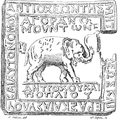Mine (weight unit)
The mine ( Latin mina , ancient Greek μνᾶ , Hebrew manäh , Akkadian Manû or Manāʾu Sumerian MA.NA ) was an ancient unit of weight of oriental origin that was widespread in the Middle East and the Mediterranean . In Greece and Persia , it was one of the most common weight units alongside the stater . In the Near East it was used under the name Mann or Manā until modern times.
Relation to other ancient weight units
A talent was generally divided into 60 mines. However, the subdivision of the mine was locally different:
- 50 shekels in Babylon
- 60 shekels in Mesopotamia
- 100 drachmas in the Greco-Hellenistic world
According to Galenus , the Attic and Egyptian mine consisted of 16 ounces , while the Roman and Alexandrian mine consisted of 20 ounces. At another point Galen quotes Cleopatra VII with three complete series of dimensions:
- 1 mine in general = 16 ounces = 128 drachmas = 384 scrupels = 768 oboli = 1152 thermoi ( lupine seeds ) = 2304 siliquae = 6144 ary
- 1 Attic mine = 12.5 ounces = 100 drachmas = 300 scrupels = 600 oboli = 900 lupins = 1800 siliquae = 4800 ary
- 1 Ptolemaic mine = 18 ounces = 144 drachmas = 432 scrupels = 864 oboli = 1296 lupins = 2592 siliquae = 6912 aerei.
Pedanios Dioscurides is quoted as saying that the Italian mine had 18 ounces, the Alexandrian mine even 20. Epiphanios of Salamis states in his treatise on weights and measures that the Italian mine = 20 ounces = 40 stater = 1 2/3 Libra . According to Isidore of Seville, the mine of 100 drachmas is divided into 75 solidi or 25 staters.
Conversion into the metric system
The weight of a mine during the Peloponnesian War was about 430 grams. The basis of the Attic coin standard was the tetradrachm made of silver with a weight of 17.2 grams. From this, the weight of an Attic (or Athenian) silver mine can be determined to be 430 grams (25 tetradrachms of 17.2 grams each).
According to MH Sauvaire, the 16-ounce refill = 423 grams, the 20-ounce refill = 529 grams, the 12.5-ounce refill = 331 grams and 18-ounce refill = 476 grams.
Cultural history
Diodorus Siculus states that the Balearic slingers in the service of Hamilcar fired stone projectiles with a weight of a mina at the battle of Himeras (310 BC) (Book XIX, 109). The term “ menetekel” is also derived from the mine.
Mine of Chios
Mine of Antiochus IV.
Mine of Antioch on the Orontes
literature
- Konrad Hitzl and Werner Huss: Mina. In: Hubert Cancik, Helmuth Schneider (antiquity), Manfred Landfester (history of reception and science) (eds.): The new Pauly . On-line
- Tyll Kroha: collect coins. A guide for collectors and enthusiasts. Klinkhardt & Biermann, Braunschweig 1961, 1968, Munich 1985 (6th edition). ISBN 3-7814-0249-5
- MH Sauvaire: Matériaux pour servir à l'histoire de la numismatique et de la métrologie musulmanes in Journal Asiatique VII / 4 (1884) 207–321. Here pp. 280–282. Digitized version (Latin text passages)
Individual evidence
- ↑ See Chicago Assyrian Dictionary . Vol. X / 1, pp. 219-221. Digitized
- ^ See ADH Bivar: "Weights and Measures 1. Pre-Islamic" in Encyclopaedia Iranica online version .
- ↑ Julius Berendes: The pharmacy among the old civilized peoples . Tausch & Grosse, Halle, 1891. Vol. I, p. 262. Digitized
- ↑ Cl. Galenos Pergamenos: Omnia, Qvae Extant: In Latinvm Sermonem Conversa; 6. Quinta classis, eam medicinae partem, quae ad pharmaciam spectat, exponens. Froben, Basel, 1562. p. 555. Digitized
- ↑ Cl. Galenos Pergamenos: Omnia, Qvae Extant: In Latinvm Sermonem Conversa; 6. Quinta classis, eam medicinae partem, quae ad pharmaciam spectat, exponens. Froben, Basel, 1562. p. 557.
- ↑ Sauvaire: Matériaux pour servir à l'histoire de la numismatique . 1884, p. 281.
- ↑ Sauvaire: Matériaux pour servir à l'histoire de la numismatique . 1884, p. 282.
- ↑ Darel Engen: The Economy of Ancient Greece. "EH.Net Encyclopedia, 2004. (See the section Money and Banking: The basis of the Attic standard was the silver tetradrachm of 17.2 grams)
- ↑ Sauvaire: Matériaux pour servir à l'histoire de la numismatique . 1884, pp. 281f.




